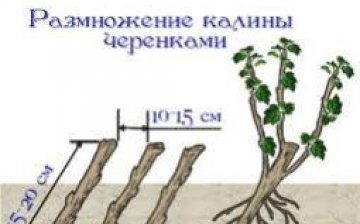Reproduction of viburnum
Viburnum propagation can be carried out both by seeds and by a vegetative method (cuttings and layering). Viburnum propagation in these ways is highly effective.
Seed propagation of viburnum consists in growing seedlings from individual seeds, and after a year or two, the seedlings can be transplanted to a permanent place. It is advisable to harvest seeds from the most productive, as well as large-fruited plants. The seeds should be separated from the pulp and then rinsed with water. The seeds are dried, such seeds will remain viable for about two years. You can plant seeds in autumn or spring. It is preferable to sow seeds in the spring after stratification. Seedling care consists in weeding and loosening the soil, watering and feeding the plants.
Vegetative propagation retains individual characteristics and allows you to get good planting material.
The easiest way is to reproduce by layering. Shoots are rooted with this method without separation from the mother bush. In the spring, annual growths are bent down on nutritious loose soil and pinned. Shoots develop from the buds of bent branches. When they reach a height of 12 centimeters, they are huddled. After a while, the second hilling is carried out. The branch is cut at the base of the bush in the fall, when the layers are completely rooted. Strong cuttings can be used as seedlings, and weak ones are grown.
Viburnum can be propagated by cuttings. Lignified cuttings are best harvested from the top of the shoot just before planting. Cuttings are planted obliquely in loose, moist soil. Plantings need to be watered and loosened frequently.



